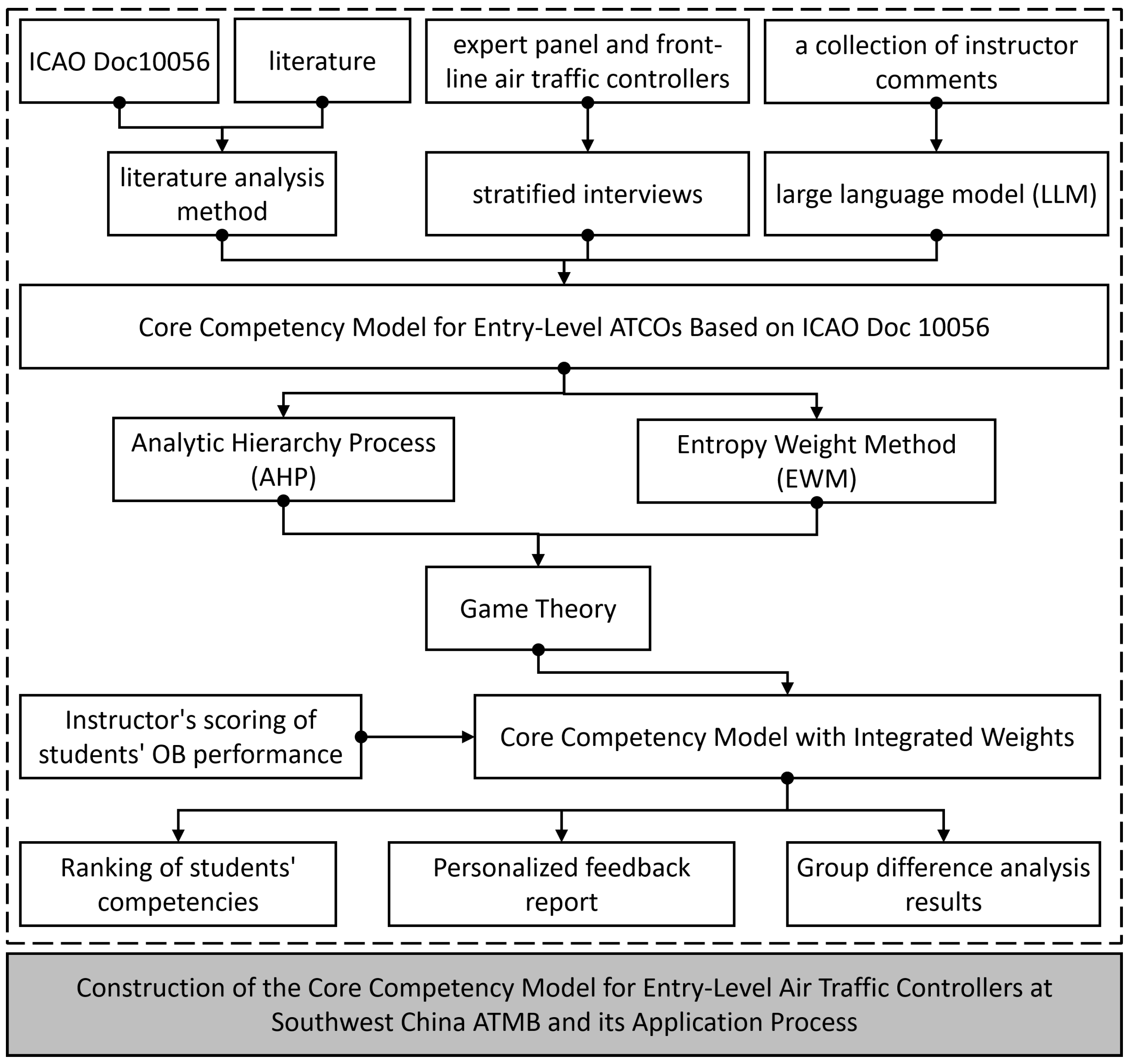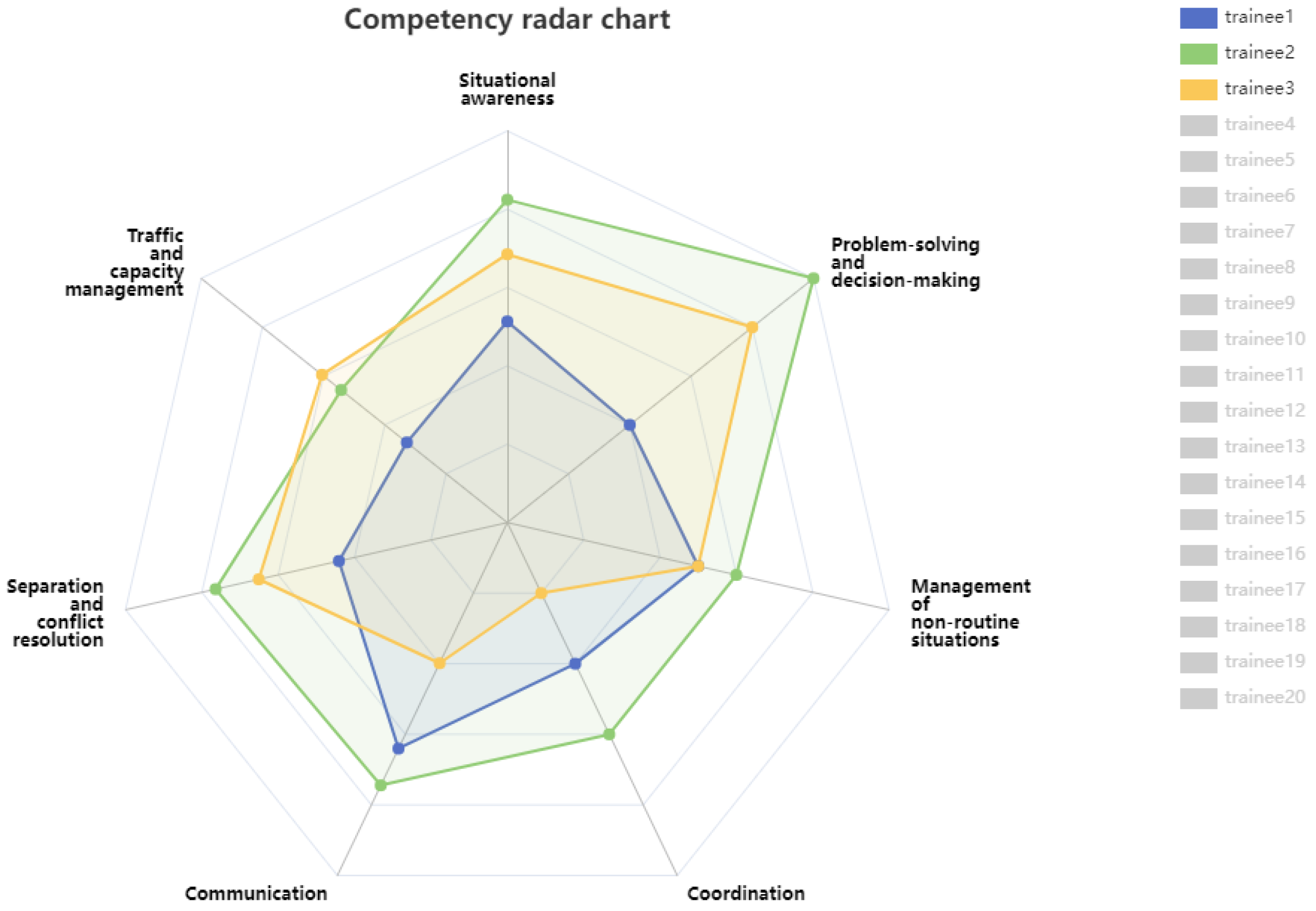1. Introduction
With the rapid growth of global air traffic and the increasing complexity of air traffic management, air traffic controllers—being the core human resource in aviation safety operations—have a direct impact on airspace operational efficiency and flight safety. The International Civil Aviation Organization (ICAO) clearly stated in Doc 10056—Manual on Air Traffic Controller Competency-Based Training and Assessment—that constructing a competency-based training system is a key approach to addressing the standardization of controller capabilities [
1]. In the coming years, the Federal Aviation Administration (FAA) will face a significant loss of air traffic controllers, with an estimated loss of 8595 controllers from 2021 to 2030, including retirement, promotion, transfer, and loss during training. To meet this challenge, the FAA plans to recruit approximately 8854 new controllers during this period to meet the needs of air traffic control [
2].
Currently, the Chinese civil aviation controller training system divides training into separate subjects, which limits its flexibility; each subject must be taught and assessed independently. When faced with complex or rapidly changing situations, this approach may fall short, as trainees may only exhibit skills related to isolated tasks and fail to respond effectively to realistic operational scenarios. Moreover, qualitative analyses of individual trainees lack traceability throughout the training process and cannot provide scientific and reasonable guidance for future improvement. The Civil Aviation Administration of China (CAAC) has proposed an assessment model that emphasizes three key areas: core competencies, psychological capabilities, and professional work style. Within this model, core competencies are identified as the crucial determinant of an individual’s ability to successfully perform their designated tasks. It is further stipulated that the core competency framework forms the bedrock of the entire Evidence-Based Training (EBT) system, thereby providing a definitive basis for the establishment of training objectives. This approach ensures that personnel can comprehensively apply their knowledge, skills, and attitudes to effectively manage real and complex operational environments, particularly when encountering complex conditions or rapidly evolving situations, ultimately leading to enhanced safety and efficiency [
3]. The main purpose of this study is to establish a core competency model that meets international standards and adapts to the localization needs of the Southwest Air Traffic Control Bureau through systematic research, and then quantify ATCO capabilities through instructors’ scoring of observable behaviors. Finally, quantitatively analyze ATCO capabilities and provide training program recommendations for the bureau.
In the field of competency research, Taylor argued that through time and motion studies, managers can distinguish between high-quality and high-performance work processes, identifying key contributing factors [
4]. In 1973, McClelland from Harvard University first introduced the concept of “competency”, which has since become a research focus in fields such as organizational behavior and human resource management [
5]. In 1991, Boyatzis further aligned competency indicators with specific industries and clarified the primary methods for collecting and analyzing competency characteristics [
6]. In recent years, competency models have been widely used in recruitment and training. Examples include the 3M’s model for senior managers, modular modeling methods for multi-role functions, and the seven-step modeling process in the healthcare industry—all reflecting the diversified development of competency models. Scholars have also discussed the distinctions between “capability” and “competency” and evaluated model effectiveness [
7,
8,
9,
10,
11,
12]. In 2001, the Australian government defined five core competencies for public sector leadership: professional ethics and integrity, effective team communication, critical thinking, operational control, and competitive communication abilities [
13]. Competency models have been extensively applied in talent assessment, training, and performance management, offering advantages such as strategic alignment and performance orientation. Studies have proposed best practices for modeling while pointing out the need for improved definitions and methodologies. Some models have demonstrated effectiveness in enterprises and educational contexts, and with the integration of information technology, their application efficiency and personalization levels have been enhanced [
14,
15,
16,
17,
18]. These generic competency frameworks and their evolution provide the necessary context for understanding more specialized models, while these studies provide a broad perspective on competencies, their application to safety-critical and highly specialized roles, such as the aviation industry, requires a more context-specific approach.
The successful application of competency models in professional capability assessment has indeed yielded significant results in various fields. For instance, research in corporate HR has demonstrated that competency-based career management systems can improve employee performance by 20% and reduce turnover by 10% [
19]. Particularly relevant to the aviation sector, Haiwen Xu et al. (2024) proposed behavioral indicators of core competencies for pilots, aiming to support pilot training and enhance flight safety [
20]. This underscores the value of tailored competency frameworks in high-consequence professions.
Regarding the study of the air traffic controller competency model, in 2006, Esther Oprins conducted a study based on the Dutch air traffic control system and constructed a controller competency model based on competency assessment. The model classifies various competencies by importance, including situational awareness, decision making, emergency response, workload control, conflict resolution, multi-tasking, prioritization, coordination and communication, flexible planning, leadership, teamwork, and perseverance [
21]. The International Civil Aviation Organization (ICAO), the Federal Aviation Administration (FAA) of the United States and the European Organization for the Safety of Air Navigation (EUROCONTROL) have also conducted research on the competencies of air traffic controllers and applied them to training and assessment. A key framework is the European Union Regulation (EU) 2015/340 [
22], which specifies the common technical requirements and management procedures for air traffic controller licenses and certificates. Although the EU regulation specifies common core competencies for initial training, it does not specify how training organizations should define and use assessment criteria to assess competencies by observing the behavior of candidates. In 2017, ICAO published Doc 10056.
A. Luppo summarized assessment methods for controller competencies, including continuous assessment, targeted assessments, and hybrid approaches. Assessment content covers theoretical knowledge, radio communication and coordination, interpersonal communication, numerical sensitivity, traffic planning, special situation identification, response ability, situational awareness, application of minimum separation, flight crew requirements, fatigue recovery, and teamwork. His findings emphasize the need to evaluate not only controllers but also instructors and management personnel. In 2018, S. K. Soldatov identified the fundamental core skills of ATCOs as the perceptual abilities to search, detect, and identify targets, and the decision-making capabilities to resolve conflicts [
23].
Although mature ATCO competency frameworks exist internationally, these frameworks do not fully consider China’s national conditions or the specific context of the Southwest Air Traffic Management Bureau. Differences in operational environments, regulatory standards, infrastructure, and management philosophies between Chinese and international ATC units lead to divergent competency requirements.
Domestically, early research into controller competency models began with Wang Peng, who suggested that introducing competency models can effectively improve training needs analysis and optimize training structures [
24]. Xu Nuo (2007) examined the competency characteristics of Chinese ATC personnel and constructed a model using hypothetical methods, proposing a framework for evaluating controller performance to support selection and training [
25]. In 2016, Xu Hongjia studied 746 controllers from the North and Southwest ATC bureaus and found a significant positive correlation between job stress and burnout, paving the way for incorporating psychological factors into competency models [
26]. In 2018, Li Jianqiao and Zhong Fengwei developed a competency model for ATC supervisors using literature reviews, case studies, behavioral event interviews, expert panels, and surveys, thus advancing the refinement of competency research for specific ATC roles [
27]. In 2020, Lai Guijin, Ma Xuepeng, and Wu Dingjie pointed out new challenges in ATCO training under evolving requirements and emphasized the utility of competency theory in guiding training and adapting to new demands [
28]. In 2022, Liu Chengxue summarized current issues such as regional disparities in controller development, selection systems, professional quality, training, and exit mechanisms [
29]. Liu Che emphasized that competency models support efficient training and provide reference frameworks for promotions and talent development [
30].
Despite technological advances enhancing safety and efficiency in aviation systems, air traffic control remains heavily dependent on human cognitive abilities. With increasingly complex airspace and the integration of UAVs, establishing a scientific competency model for entry-level controllers is more crucial than ever [
31]. C. Duan developed a competency model to calculate the position-fit scores of individual trainees [
32]. However, most of these efforts rely on generic models and none of them build the core competency model for air traffic controllers according to the framework in ICAO Doc10056. The Southwest Air Traffic Management Bureau, in contrast, requires a more differentiated approach due to its controller career progression structure—ranging from entry-level controllers to solo controllers, instructor controllers, and team leaders. Additionally, solo, instructor, and team leader roles are further divided by control domains: tower, approach, and area control. These variations result in significant differences in required competencies across roles.
In December 2020, the Civil Aviation Administration of China released the Implementation Plan for the Construction of a Professionalized Full-Lifecycle Management System for Civil Aviation Transportation. Based on this, the present study conducts a preliminary exploration into the core competency model of controllers from a lifecycle perspective, tailored specifically for the Southwest Air Traffic Management Bureau. It aims to construct an entry-level controller competency model for the first time based on the ICAO 10056 framework. This study used literature analysis, expert interviews and empirical methods to establish a multidimensional core competency model covering indicators such as situational awareness, traffic and capacity management, communication, coordination, and their sub-elements and observable behaviors (OB). In addition, a set of comments that meet the requirements of ICAO Doc10056 evaluation standards was constructed for instructors to choose from through LLM. It then scientifically determines the weights of each dimension and indicator. Instructors score OBs to quantify each trainee’s competencies and generate recommendations for the bureau’s training programs.
This study is based on the guiding ideology of the “Implementation Plan for the Construction of the Lifecycle Management System of China’s Civil Aviation Transport Occupation” issued by the Civil Aviation Administration of China in December 2020, and provides a quantitative basis for the selection and assessment of air traffic controllers. The core goal of this study is to build a scientific and multi-dimensional core competency model for entry-level air traffic controllers for the Southwest Air Traffic Control Bureau and explore its application methods. To achieve this goal, this study will for the first time take the framework of the International Civil Aviation Organization (ICAO) Document 10056 as an important theoretical basis, and comprehensively use literature analysis, expert interviews, and empirical research methods. Specifically, the research will focus on establishing a core competency indicator system covering key dimensions such as situational awareness, traffic and capacity management, communication, coordination, and their subordinate elements and observable behaviors (OB); and then determine the combined weights of the competency indicators of each dimension through game theory combined with the subjective and objective weights obtained by AHP and EWM; and through standardized scoring of the instructor’s evaluation of the observable behavior of the trainees, to achieve a quantitative assessment of the trainees’ abilities, and provide suggestions for the optimization of the training program of the Southwest Air Traffic Control Bureau. The specific research roadmap is shown in
Figure 1.











